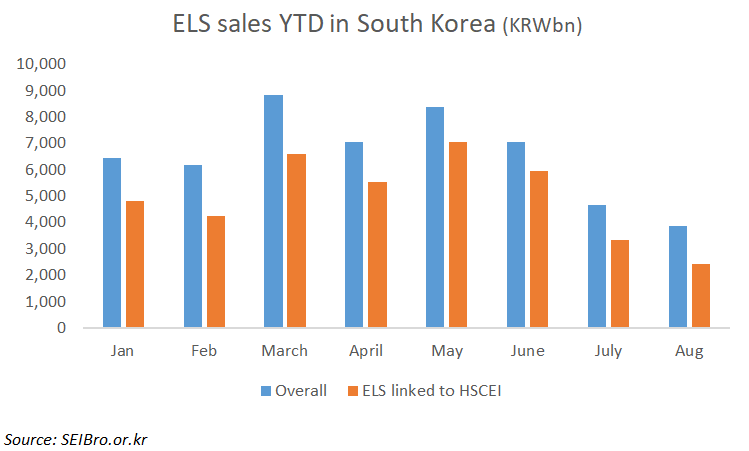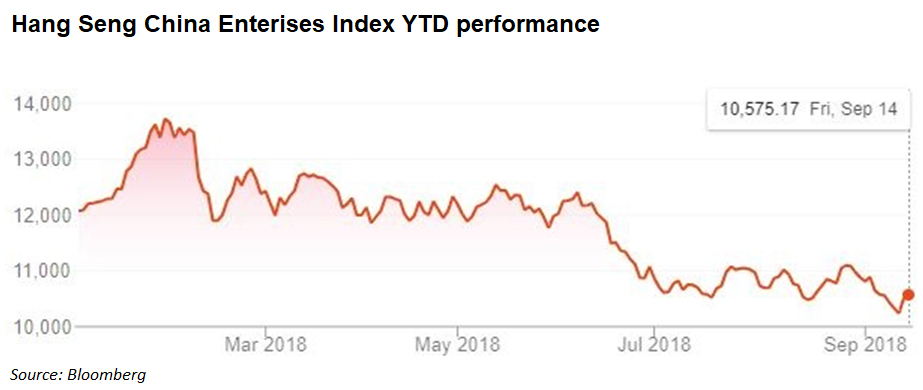South Korea's securities firms are shying away from equity-linked securities (ELS) in the second half of this year, with the sales volume in August at its lowest level so far this year. The downward trend is mainly attributed to the bearish Hang Seng China Enterprises Index (HSCEI), which is one of the most popular underlyings for the domestic structured producta market.
The issuance volume of ELS in Korea last month came in at KRW3.85 trillion (USD$3.43 billion), dropping below the KRW4 trillion level for the first time this year and marking three straight months of decline, according to SEIBro, the securities information portal run by Korea Securities Depository (KSD).
ELS linked to HSCEI recorded an increase in sales in the first half of the year when overall issuance volume of the ELS was also on the rise. The increased sales came on the back of the recovery momentum of the benchmark coupled with a regulatory restrictions that came to an end late last year.

The sales volume of HSCEI-linked ELS, however, soon plunged to less than KRW2.5 trillion in August from over KRW7 trillion in May after market sentiment dampened later in the year. The HSCEI which soared in January to near the 14,000 level now hovers below the 11,000 mark, reminding investors of the 2015-2016 market turbulence. In November 2015, Seoul's financial regulators put a restriction on the total volume of issuance of the product due to drastic falls in the HSCEI, resulting in investors incurring in heavy losses.
"A drop in an underlying index does not necessarily mean a drop in (ELS) issuance, if expectations for a rise exist," said Gil-nam Nam, head of capital markets at Korea Capital Market Institute. "But market demand is not so high at the moment amid the ongoing trade war between the US and China."

While a stronger US dollar trend and concerns over emerging market contagion stemming from Turkey as well as Argentina are worsening investors' appetite to look for riskier assets, Korea's financial authorities in July also pledged to boost monitoring on banks for signs of mis-selling of ELS products tracking the HSCEI after seeing increased sales in the first half of 2018.
Still, bankers in Korea brushed aside worries over a potential market crash like the one seen a couple of years ago, saying there is room left for further drops to trigger a knock-in option, according to the report. The so-called Hong Kong H-index is widely included in the country's auto-callable structures as an underlying asset due to its volatility that raises the return level of a product.
"Back then, the HSCEI plummeted to 7,800 level from 15,000 level in just two months," said Chang-gyu Choi (pictured), derivatives analyst at NH Investment and Securities. "The drop was very exceptional; it was a black swan event. The drop in the index now, is not that drastic, rather, the trend should be described as failing to go up."
Choi added the drop in ELS sales volume in the second half is more of a reflection of a global investor trend of increasing cash levels.
"Local investors opt to hold cash as there aren't many attractive investment outlets right now," said Choi. "The US Federal Reserve is raising rates and Korea's finance minister also pressured the Bank of Korea about a rate hike. In that sense, riskier assets like stocks and of course, ELS, become less attractive."
Choi expects ELS issuance could rise once the HSCEI goes back to a more stable rally, "but it's difficult to predict when".
Related Stories